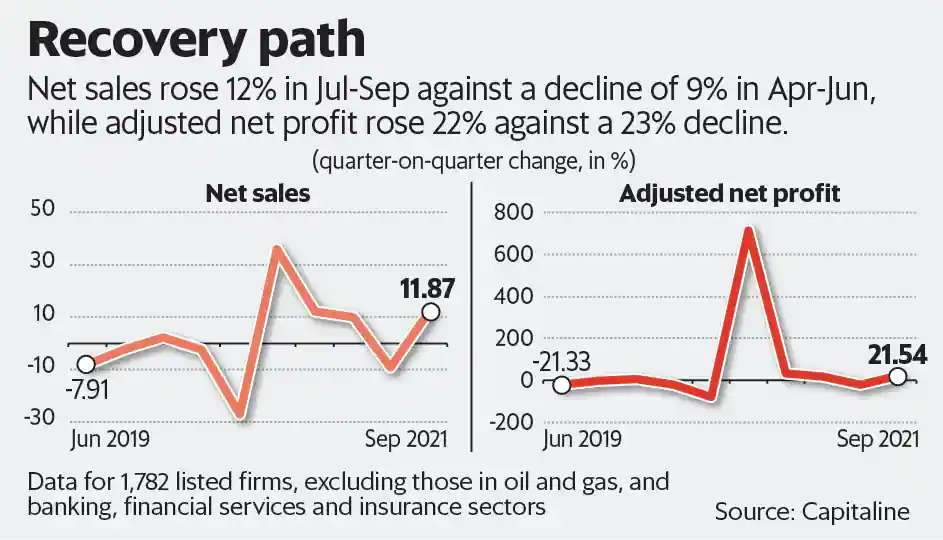MUMBAI :
Companies delivered a resilient performance in the September quarter, with demand recovering in response to the reopening of the economy, overcoming a challenging environment in which commodity inflation squeezed profit margins.
A Mint analysis of 1,782 companies showed net sales rose 11.9% sequentially in July-September from a decline of 9.39% in the preceding three months. Profit adjusted for non-recurring items climbed 21.5% in the September quarter against a decline of 22.7% in the previous quarter.
The analysis excludes oil and gas and banking, financial services and insurance (BFSI) companies as they have a separate business model. “I would summarize the result season as ahead of expectations on revenue growth and broadly in-line with regards to earnings. Whether it’s credit growth pick-up or consumer spending, I reckon that growth has been better than expected. The growth outlook is positive. While revenue growth was ahead of estimates, the earnings picture was two-faced between consumer-facing companies and commodity-related companies. Consumption-oriented sectors that are commodity users of India Inc. did face headwinds on margins front,” said Trideep Bhattacharya, co-chief investment officer, equities, Edelweiss AMC.

View Full Image
He said commodity-related sectors delivered a positive earnings surprise, driven by high commodity prices, while management commentaries, particularly in pockets with pricing power, talked about pricing increases to neutralize the impact of commodity costs on margins in coming quarters.
During the quarter, the net profit margin of the companies under review rose to 9.49% from 9% in the previous quarter. However, the operating profit margin narrowed to 22.64% in the September quarter from 23.46% in the preceding three months. Interest outgo was still lower, declining 3.56% in the quarter, but raw material costs jumped 14%.
Dhananjay Sinha, managing director and chief strategist, JM Financial Institutional Securities Ltd, said the revival in consumer demand and general activity level across businesses aided sales growth, but there is widespread raw material inflation that is also emerging.
“Thus, operating profit at the aggregate level has missed expectation by 5%, but revenue has been ahead of expectation by 5% odd. Margin pressure was most evident in sectors such as autos and cement. Notwithstanding, the post-second wave demand recovery, corporate performance over the next few quarters would be broadly driven by elevated material costs, a rise in crude oil and energy prices, the impact of domestic coal and power shortage on various industries, higher raw material and logistics costs and higher inflation on wage costs and supply shortages of imported inputs/finished products from China, which is slowing. It is evident that, depending on the pricing power, many companies will initiate price hikes to compensate for input costs,” he said.
Sectors such as metals and pharma reported better quarterly earnings while autos, consumers and infrastructure disappointed. For instance, net raw material costs borne by Hero MotoCorp were higher by 110 basis points sequentially even as it took price hikes of ₹3,000 since April this year in phases.
Analysts said margin pressure is visible across sectors, and companies have said they will raise prices. However, there are concerns over possible demand impact due to price hikes amid inadequate income recovery, especially in unorganized segments.
As evident in the September quarter earnings, the biggest risk ahead is the margin impact due to higher raw material prices. As a result, earnings downgrades have been seen in sectors like autos, chemicals, consumers, infrastructure, telecom and utilities; conversely, metals, oil and gas and pharma have seen some upgrades in earnings, Sinha said.
Earnings recovery is critical to justify the steep valuation Indian markets are currently at, as a few global brokerage houses have already downgraded Indian equities.
“Despite the recent correction, Nifty continues to trade at 20.5 times FY23 earnings estimates. With covid vaccinations rising, urban recovery is likely to see a strong revival as cases remain low,” said Gautam Duggad, head of research, institutional equities, Motilal Oswal Financial Services Ltd.
Never miss a story! Stay connected and informed with Mint.
Download
our App Now!!

